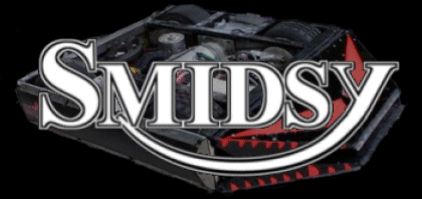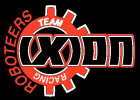The lessons from Robot Wars 1999
A personal account from Mik Reed
We came out of filming in 1999 licking our wounds and knowing we needed to make changes.
We had more body damage than we'd initially thought, but had also answered some of our worries. We knew we couldn't do anything without better radio control of SMIDSY and that we needed a crash course on that part of the hobby.
We also knew that we wanted to be back in the thick of it in 2000!
The easy bit... Andy had spotted some titanium covered in dust at a neighbouring university. Ignoring our (naturally jovial) suggestions to 'just borrow it' he got in touch with them and once he'd convinced them that they did actually have some laying around got given a sheet! This was enough to replace the aluminium backing plates for the side and rear armour and to build boxes to contain all of our electronics (see "The hard bit" below). Only problem was we needed more gas main...
A build weekend was arranged and after much to-ing and fro-ing the correct size of pipe (or something resembling it) was sorted out, only downside was that it was in Slough. Still, that's almost en-route from Crawley to Huddersfield, hardly a detour at all. Late Friday night, or possibly early Saturday morning Robin and I arrived in Slurrit with all the bits and pieces, including a bit of gas main Andy could crawl through!
We were met by Steve Bennett on the Saturday and between us we built new side armour (the pipe we ended up with was a bit big so the panels got thinner and more solid.) New leatherette was stuck on the plastic and it was bashed into solid titanium backing panels. We suffered from the old aluminium panels peeling off of the mounting points, so Andy came up with a new stronger fixing method. We had also come across problems with the old captive nuts meant to hold on the side panels so these were replaced with a different type, fitted by some devious test-your-grip rivetter-style tool. Unsuprisingly Andy won that one!
Steve did some cable making and note taking and the jaw wiring was rethought. We didn't bother replacing the rear tyre as SMIDSY still ran happily. The top armour was up for replacement and Andy had an idea to thwart the Stihl saw on Dead Metal which he wanted to incorporate into it, along with better wheel protection. We decided to replace top and bottom even though the bottom armour was barely touched and the dents caused by the arena spike (which had gone straight through Rattus Rattus' 1/2" ply base) were easily banged out.
The hard bit. We knew our control was a problem, we didn't know why. It could have been interference from the motors, obviously something was picking up outside interference, we just didn't have the knowledge, so we started amassing some.
Andy started building helicoil antennae matched to 50 ohms and 40Mhz. We started to talk to people who pointed out some basic errors in SMIDSY's set-up. To make wiring easier we had used the chassis as the ground, standard automotive practise. Oddly we'd neglected to spot that cars and bikes were rarely remotely controlled. If they were, it'd be done differently! The theory is simple, an interference field is set up between the positive and negative cables. A good set-up has them the same length and twisted together; a bad set-up, well, looks like SMIDSY did basically!
Our antenna had been chopped about like crazy, this was a problem as while we couldn't get anyone to confirm what length they should be, or what problems cutting them creates we could get loads of people to tell us 'ooh no you don't want to cut/squeeze/tamper with that at all...' Also we were taking our antenna out to the side panel through a small hole in the chassis, which acted as a perfect choke to the signal being carried down the wire and then into the side pod where we sandwiched it between the gas main and a sheet of aluminium. Not good.
Back inside SMIDSY, we had supressed the Bosch motors a bit but had guessed at the values, this could have been a problem. All of our electronics sat unshielded within the metal box that was the 'bot, sharing space with big DC motors, all the power wiring and whirring chains, which could apparently cause problems of their own. To finish off the catalogue of horrors the cable we used to run the 4QD boards from the Team Delta interfaces was unshielded and ran straight across one of the Bosch motor bodies.
We actually tried to get scientific at this point and Kevin Cordina came down and ran across the 'bot with an oscilliscope. He proved our good points, but also showed up that the cable linking the Team Delta boards to the 4QD boards, which carried a plain analogue signal, was picking up interference like it was going out of style!
We went through these problems one by one, the wiring loom was completely redone with the leads as perfectly matched as we could manage lengthwise and twisted together throughout. The cable connecting the speed controllers to the interfaces was replaced with a fully shielded version professionally made. A new antenna was bought and various alternate antennae were tried. Until a new location could be decided we went to a small 40Mhz whip antenna on the top of the 'bot.
Some of the titanium went into building a box for the speed controllers and a box for the radio gear. This was also part of another branch of learning. Initially we had shied away from lots of connectors, attempting to have as much as possible soldered and permanent. Watching Series Two had brought home the number of people who could be knocked out by a rogue connection coming loose. The downside of this was a strip and rebuild time for the 'bot of around a day and any job being a strip and rebuild job. By the end of Series Three filming we had realised that this was just not the way to go. So SMIDSY was rebuilt compartmentalised. We can now remove bits separately and a full strip and rebuild is probably down to around 4 hours, the main problems occuring when stuff like motors need unbolting and refitting. Starts to make you appreciate the work that's gone into motorbikes so that they can be stripped and rebuilt with relative ease!
This all came together to give us a better reception, but not an excellent one. Andy was slowly coming to the opinion that the jaws needed altering radically and this was part of the final solution.
The Jaws. We had problems with the jaw drives in Series Three. They were driven using the standard jag motors, which were a bit small and hard to mount. They were driven through flexible speedo style drives which were hard to mount, especially with the limited space we had, and prone to snapping. The night before Series Three filming we were welding new mounts to the chassis to try and help this, yes a full strip down job.
Post filming we were still not happy. Andy's first change was to junk the jag motors and use the spare windscreen wiper motors & gearboxes we had in stock. These were repositioned along the front bulkhead and UV joints and connecting fireglass rods were put in place to connect to the actuators. This made the whole process easier, with the side effects of more strength and more space within the 'bot.
The Team Delta relay boards were used to run automotive 24V relays to operate the jaws as we were blowing the relays on the TD boards. This still wasn't sufficient and Andy created a damper circuit using diodes to solve it once and for all.
To house the antenna, and save some of the weight we'd spent elsewhere the metal jaws were junked in favour of a spaceframe with the sides in steel and the faces in polycarbonate. The leading edges were made of tool steel.
With range still a worry Andy made the single biggest change. We'd been talking about replacing the analogue FM transmitter and receiver for ages but hadn't been sure what to get. We'd fixated on Multiplex as being the best make available but faced with a large bill just hadn't been willing to commit. Andy went out and bought a Multiplex Cockpit Tx and a 7 channel IPD Rx. Using a hybrid of analogue and digital this set-up is designed to give good interference-free signal without the lag from which full digital systems can suffer. Our range went up and our worries were finally solved.
It had taken many months but we were finally ready for the Live Event, the qualifying event for the TV show.

